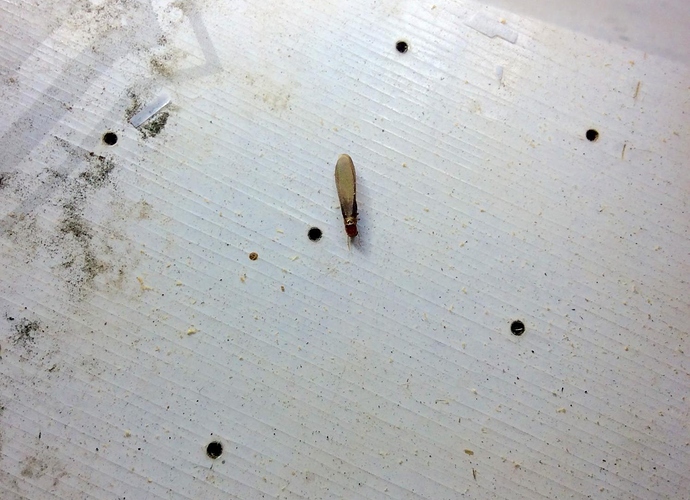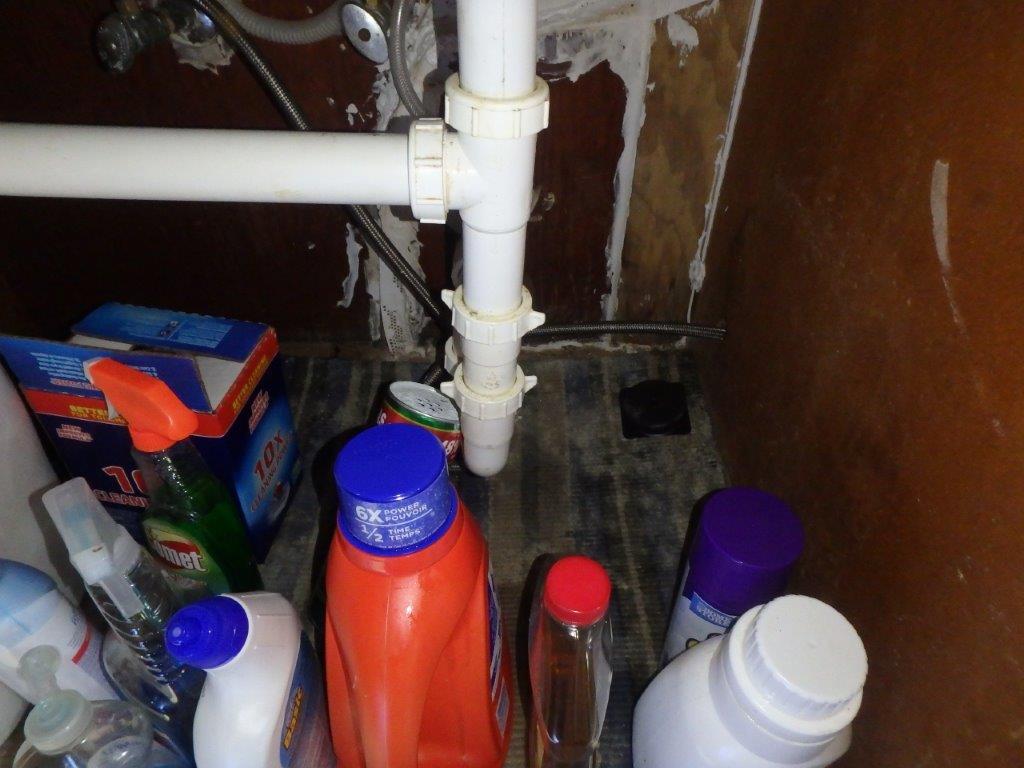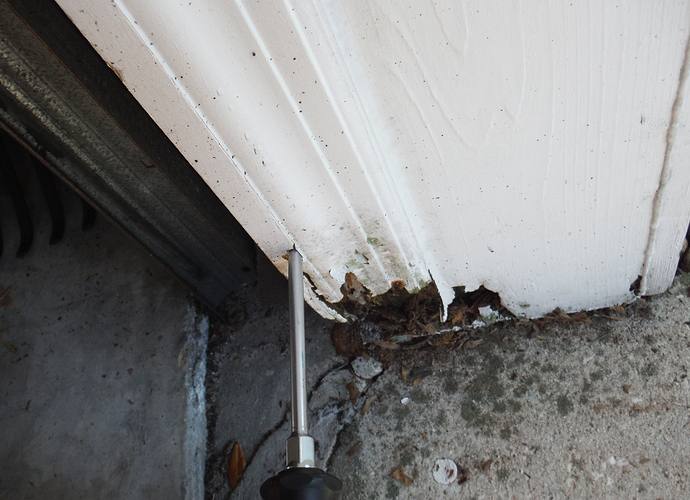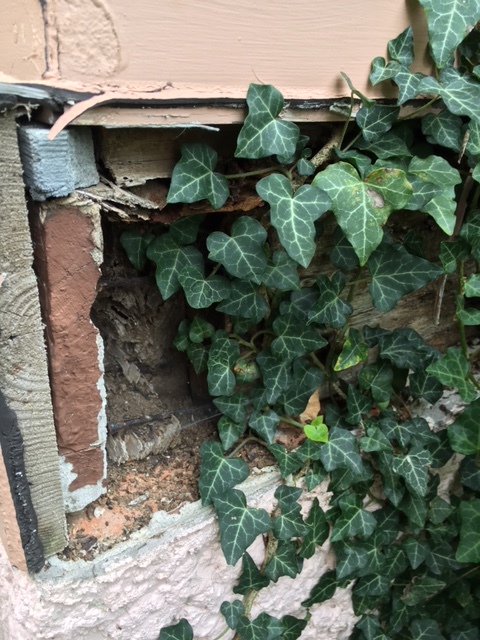Read an article on Adjustable Steel Columns. We have all seen these in basements. I was unaware that the IRC require these post be no less than 3" in diameter. I also did not know that visible signs of rust constitute a potential defect. I have noticed many of these post in basement that were not correctly secured to the floor joist. The last one I saw only had one screw in it even though there were 4 screw holes shown.
The attached photo is an image of a soldier termite. This was found in a decayed stump on the property inspected. These are a sexually immature male or female termite whose primary function is defending the colony. These termites cannot feed themselves but are instead fed regurgitated food from colonies worker termites.
Taking (3) Photos of the water meter at the end of the inspection is a great precaution to help ensure that no hidden leaks exist that were not identified during the course of inspection. Time stamping these photos or slightly changing the angle of the photo to show a difference from each photo taken can also be used to ensure no water fixtures were left on after leaving a property. These photos can be invaluable should a party accuse an inspector of missing a leak or leaving a fixture running and causing water damage to an inspected property.
This is a photo of a termite that I found on the table outside of my house. It’s hard to tell in this photo but the head of the termite is orange in color. Also, there are several dark veins branching out through the wings of this termite. These features help identify this as a Drywood termite. The subterranean termite would have a black head and only one vein near the leading edge of the wing. In the region where I live, Drywood termites account for the majority of structural damage caused by wood destroying organisms.
The article I read for this assignment was “Woodpecker Damage Prevention and Inspection” by Nick Gromicko. Damage to homes by woodpeckers is rare in urban settings but can be extensive in suburban and wooded areas. Woodpeckers use their long strong bills for boring holes into wood in search of insects to eat. Besides the obvious visual damage caused by woodpeckers, the holes that make in residential structures also encourages infestation of insects and other animals, and creates a place for moisture intrusion. Woodpeckers may also create large holes in wood siding, then nest behind the siding.
To prevent further woodpecker damage, a homeowner could place a cavity-type nest box on buildings near nesting damage. This will encourage the woodpecker to nest in the box instead of the house siding, but this method will not stop them from causing damage from foraging for food. A homeowner could also install mesh netting on the home to discourage woodpeckers. The netting should be hung for the eaves in front of the damaged areas. This will prevent the woodpecker from being able to access the area where they were previously foraging. Another method would be to build with material that does not attract woodpeckers, especially in wooded areas. According to a study by Cornell University, building homes with clapboard or non-wood siding are best. The same study also recommends painting the exterior instead of staining it. A homeowner could also apply pesticides or other insect control methods to kill the food source of the woodpeckers.
These are only a few of the recommendations for controlling damage caused by woodpeckers. A home inspector whose clients complain of this type of problem can advise them on the benefits of using appropriate building materials as well as effective techniques to discourage future damage from woodpeckers.
Moisture present under kitchen sink. Active leak observed at cold water shutoff valve. Valve leak should be repaired and damaged wood should be replaced. Sink cabinet sags at bottom and should be repaired/ replaced.
Ant Inspection
I read the article on Ant Inspection to further my understanding of these common insects. In Texas ants are very common. I often see acrobat ants that have taken over a previous carpenter ant colony. I often get questions about these insects. I have also seen swarmers in the spring and previously thought they were termite swarmers. I now know after this course how to properly identify these insects.
In this image, the exterior garage door frame and brick molding are in contact with the concrete floor and driveway asphalt. To the left of the frame, the bottom of the cedar siding is approximately 4’ beyond the sill plate which sits on the concrete block foundation. From the inside of the garage (not visible in the image) the floating slab covers approximately 4” of the block leaving the sill plate about 4” above the slab. The landscaping stones have been pulled back from the foundation exposing the foundation. There were no signs of any WDO activity past or present in this area at the time of the inspection.
I chose to review the Library Article “Home Inspection Equipment” as a research topic. It is true that a flashlight, electrical tester and screwdriver would be sufficient tools to get the job done. However, clearly the array of tools available to the Home Inspector go a long way in adding value to the inspection process. Not to oversimplify, but I have been using a tool belt to carry my tools and after reading this article, I will be switching to a vest.
Articles read for this course. Wood decay & wood siding inspection.
This home does not have gutters or downspouts, and the runoff from the roof has splashed back onto varies areas around the house, that have wood decay from fungi.
Popularity of wood siding has declined over the past several years, I believe mostly due to busy lives & lack of time or energy to due maintenance on it.
It is amazing how much damage can be caused by moisture. This window wasn’t properly protected with paint and it fell apart. This shows how important it really is to maintain a moisture barrier.

It is amazing how such a small creature can cause so much damage. The way they work together as a community is impressive. As an individual they don’t do any harm, but as an organized group, they cause a lot of damage.
The attached image shows a potential insect infestation in a residential home. The entrance appears to be from the main water line entrance into the home. There is frass on the floor and it is potentially a carpenter ant infestation, although no insect was seen at the time of inspection.
Article studied was “Ant Inspection”. An ant infestation can be detected by a variety of clues:
- Long trails of ants
- A few straggler ants
- Holes or cracks in walls or foundations
- Frass deposits
- A rustling sound
- Exterior nests in mulch or vegetation.
It is important to prevent entrance for ants and to eliminate sources of food for the insect.
This picture shows wood decay from being wet constantly promoting algae and insect damage. If you look close you can see some bore holes in the decayed wood. It is because the plant growth that moisture stays in this area and creates a great place for insects , fungi, and algae growth. The home owner was aware and has since remedied this by cutting out the bushes and replaced the decayed members with pressure treated lumber.
https://www.nachi.org/forum/attachment.php?attachmentid=155969&stc=1&d=1474994106
Wood decay replacement consumes 10% of wood produced in the US according to Ohio State University. Saprophytic organisms like fungi, beetles, bacteria, and worms are the culprits. Once the decay sets in other wood destroying organism like termites, carpenter ants and others can be attracted to the softer decayed wood.
It is best to keep wood components of a structure as dry and ventilated as possible to keep wood decay from destroying the structure.
If viewed closely, there are subterranean termites visible in the image. They were found in an old wood pile only a few feet from a detached garage. Due to the proximity of the wood to the garage, I would consider this a conducive condition for future termite structural damage to the garage. The old wood pile needs to be removed to limit this potential issue.
Research- Termite control
Methods of termite control can begin as soon as construction does. In new construction, a builder has several options from soil treatments to the use of pressure treated wood thru the entire first floor (sill plate to top plate). Home owners can be a first line of defense in protecting themselves thru visual inspections after they understand what to look for. From there, a reputable pest management company can tailor different treatment programs best suited to site eradication. In conclusion, a knowledgeable home owner who monitors their home and works with a responsible pest management company may greatly offset long term wood damage to their own property.
On a recent inspection, we found an area under a bay window with mulch piled up against wood trim. This was noted as a condition that would leave the wood vulnerable to damage from moisture retention and insect infestation. The condition is easily remedied by the removal of the mulch and potentially regarding of the soil to ensure sufficient clearance between the wood and the ground. Any regarding would need to pay attention to leaving sufficient slope away from the foundation for drainage.
Should a home inspector perform Wood Destroying Organism (WDO) inspections as part of a standard home inspection? The InterNACHI Standard of Practice states: “The inspector is not required to i) determine the presence of evidence of rodents, birds, animals, insects, or other pests…j) the presence of mold, mildew or fungus.” To the extent that WDO can create conditions that are arguably within the scope of a standard home inspection, the home inspector should be looking for signs of WDO and the damage they might create. If an inspector is certified or licensed to perform such inspections, then under an appropriate contract and/or addendum to the standard home inspection contract, of course such inspections can be performed. Even if not licensed and WDO are excluded from the contract, however, it would make sense for inspectors to be trained to identify the signs of WDO, and be prepared with sufficient knowledge to call out the need for a WDO inspection when signs are present.








